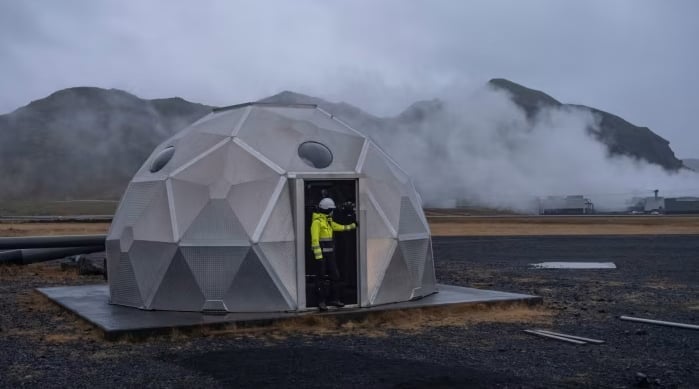December 25, 2025 | 01:37 GMT +7
December 25, 2025 | 01:37 GMT +7
Hotline: 0913.378.918
December 25, 2025 | 01:37 GMT +7
Hotline: 0913.378.918

A start-up in Iceland is developing methods to store CO₂ drawn from a nearby power plant by mixing it with water and injecting it into basalt rock. Photo: Marko Djurica/Reuters.
Far less carbon dioxide can be safely stored underground than previously thought, scientists have said, highlighting the risks of relying on a technology that is undeveloped at the scale needed to meet global climate goals.
Researchers from Imperial College London and others said in a peer-reviewed paper published in the journal Nature on Wednesday that the greenhouse gas was at risk of leaking back into the atmosphere after it has been injected underground.
The risk of earthquakes, engineering failures or territorial disputes meant that less than 1,500 gigatonnes could be safely stored, they found, compared with previous estimates of up to 40,000 GT.
Based on the median of scenarios analysed by the Intergovernmental Panel on Climate Change, the world’s leading climate science body, limiting global warming to 1.5C above preindustrial levels as laid out in the 2015 Paris agreement would mean sequestering 8.7 GT of CO₂ annually.
The level of storage required would ultimately go well beyond the safe limit laid out by the scientists, depending on the pace at which the technology is deployed.
Carbon storage should be seen as a “scarce resource” rather than “an unlimited solution to bring our climate back to a safe level”, said Joeri Rogelj, one of the study authors and director of research at Imperial’s Grantham Institute, who was one of the lead authors on the IPCC special report on 1.5C of warming.
Policymakers should plan to use carbon storage to limit the effects of global warming, not let it be “wasted on offsetting ongoing and avoidable CO₂ pollution” from fossil electricity production or outdated combustion engines, he added.
National climate plans that seek to achieve “net zero” emissions within 25 years, including in the UK and US, rely to varying degrees on the removal of CO₂ from the atmosphere and storing it underground.
Strategies also include natural processes, such as reforestation or improved soil health, but these solutions store CO₂ less durably.
Big polluters including Microsoft and Amazon are among those which invested in technology-based carbon removal projects that suck CO₂ from the air or capture it when biomass or fossil fuels are burned for power, or from industrial processes.
As these projects typically need to store the CO₂ underground once it has been captured, the industry’s potential for scale is limited by issues of cost, engineering, the availability of geologically stable land, and unintended consequences such as the pollution of groundwater from carbonic acid.
Tom Kettlety, a research fellow at the University of Oxford, said that credible industry players were already aware and transparent about these constraints. The Nature work’s results “still support — even with their pessimistic assumptions — that there are many decades worth of storage resources that can be used to get to net zero”.
Once removed from the atmosphere, CO₂ is typically stored underground in depleted oil and gasfields or in naturally-occurring rock formations. Russia, the US, China, Brazil, Saudi Arabia and Australia all had large areas of potential safe storage, the paper said.
To minimise leakage, the paper recommended injecting the CO₂ between 1km and 2.5km underground, or at ocean depths of no more than 300 metres, and in areas of low seismic activity away from water reservoirs, environmentally protected areas or contested areas.
The technology remains at an early stage, with just 600,000 tonnes of CO₂ stored underground every year, according to a report led by Oxford’s Smith School of Enterprise and the Environment.
Ben Caldecott, director of the Oxford Sustainable Finance Group, said the Nature estimates about storage capacity were still too optimistic because they did not factor economic constraints in. “Only a fraction of that estimated will be accessible at a price society will be willing to pay.”
FT

(VAN) Carbon markets are at a tipping point. The traditional divide between voluntary and compliance systems is disappearing, and this shift is more than a technical adjustment.

(VAN) In the closing months of 2025, Europe has witnessed a marked increase in cases of highly pathogenic avian influenza (HPAI) among wild birds, leading to widespread outbreaks in poultry farms and a rise in detections among carnivorous mammals.

(VAN) Indonesia Minister of Social Affairs Saifullah Yusuf said that the government is mulling a daily living allowance scheme of 10,000 rupiah (US$0.60) for each displaced victim.

(VAN) The global population is expected to grow in the coming years. This means higher demand for animal protein, and therefore, challenges and opportunities for the animal nutrition industry.

(VAN) $58.8 million from Global Environmental Facility targets efforts in Bangladesh, DR Congo, India, Mexico, Senegal, Tanzania and Ukraine.

(VAN) Chinese industry groups are urging a suspension of phosphate fertilizer exports, a move that may tighten global supply and push up prices just as U.S. farmers prepare for spring planting.

(VAN) OMB Director Russell Vought said the National Science Foundation "will be breaking up" the National Center for Atmospheric Research in Colorado.